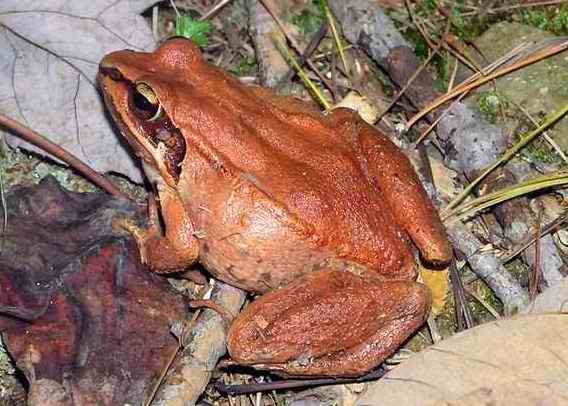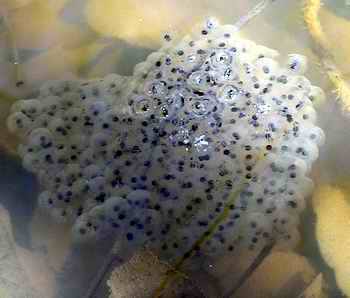|
Return to Hiker's Notebook Home Page
Common Name: Wood Frog Scientific Name: Rana sylvatica (Generic name rana is Latin for frog, said to be derived from the sound that a frog makes; species from Latin sylvanus meaning woods)
Wood frogs range from Georgia to northern Canada and Alaska. They are found farther north than any other North American amphibian or reptile and are the only frog that inhabits the region to the north of the Arctic Circle. They exhibit a wide range of color morphs from tan, rust and brown, which are the most common, to gray and even green. Their main distinguishing feature is a black band that extends from the front of the mouth to the base of the front leg. It is this characteristic feature that is responsible for the sobriquet "robber's mask" frog.
Wood frogs are able to inhabit northern climates and survive Nordic winters due to their ability to freeze about 65 percent of their bodies and subsequently thaw out without damage when warmer temperatures prevail. The mechanism that allows for this phenomenon has been subject to scientific inquiry in the field of cryobiology for over a century. The discovery that wood frogs freeze in the winter is attributed to William Schmid, a physiologist at the University of Minnesota. Having found a frozen wood frog, he surmised that it was not because it erred in not having dug deep enough to escape the cold (a practice of many other amphibians), but was rather intentional, as he proved on reviving it. His subsequent studies on the subject led to a seminal article in the journal Science entitled "Survival of Frogs in Low Temperatures."
The process that allows the wood frog to freeze is a complex adaptation that involves the production of glucose, frequently referred to as blood sugar. Glucose is the primary energy source for the cells that make up body tissue and the major nutrient for brain cells. When the temperature drops below freezing and ice crystals begin to form on the skin of the frog, a signal is generated that stimulates the adrenal gland to release epinephrine, also called adrenaline (it was given this name by the U.S. chemist J. Takamine in 1901 when he first isolated it). When the epinephrine in the bloodstream circulates to the liver, it triggers the conversion of glycogen to glucose (to provide more energy in the "fight or flight" glandular response). Glycogen is the form in which glucose is stored in the liver.
The freezing process starts outside the cells where proteins act as ice nucleation sites. Ice formation lowers the water content in this intracellular region. With a low water content outside the cells and a high water content inside the cells, osmosis results, drawing almost all residual water out of the cells. This would result in severe dehydration were it not for the glucose, which restores the osmotic balance and acts like a form of antifreeze. The level of glucose released by this process is about 4500 mg/100ml of blood. By contrast, humans are diagnosed with diabetes when the level reaches about 300 mg/100ml. Therefore, the cells don't freeze, but the surrounding areas do. The heart stops and breathing ceases and the frog becomes a comatose block of ice.
Wood frogs breed very early in the spring after they thaw out (a process not yet well understood), the males announcing the process with a call that has been characterized as a duck-like quacking sound. The males are not able to identify females by sight, but rather rely on the sense of touch. The process is iterative in that the male frog will embrace another frog in an iron-like grip and make a determination as to whether it is fat enough to be an egg-bearing female. If it is either a male or a thinner female that has already spawned, he will release it. The tight grip of the male frog is necessary to maintain amplexis (from the Latin amplectari, to twine around), the mating embrace. The male grasps the larger female's back so as to be in position to release sperm as the female releases the eggs. The entire process can take over an hour, resulting in the deposit of an egg mass that is about 10 centimeters in diameter and contains 1000 to 3000 eggs. This mass will generally be deposited in the deepest part of the pond. After about a week the egg mass flattens out and becomes covered with green algae, so that it is camouflaged as floating green pond scum. |

